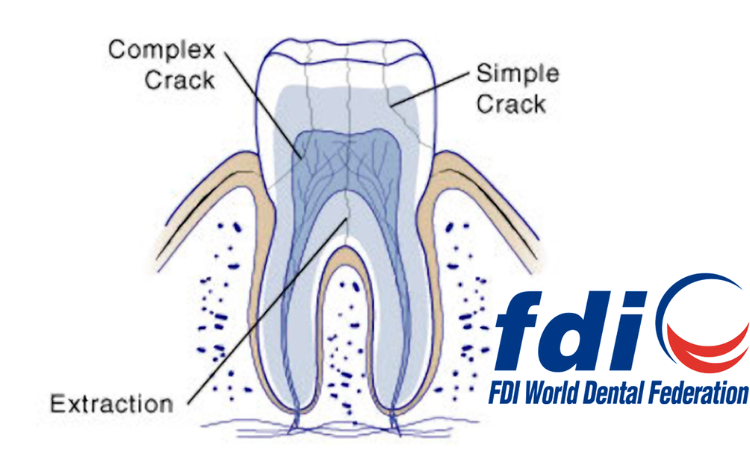
Switzerland: The FDI has issued new guidelines for Cracked Tooth Syndrome, which is both a temporary and progressive condition. The condition of CTS can be difficult to detect, require adequate treatment, and failing to do so could lead to eventual tooth loss.
In dental surgery, cracked teeth are frequently observed. A crack's severity can range from minor enamel chips to severe fractures that lead to tooth loss. Most fractures are referred to as "complete" fractures when a cusp entirely separates from a tooth. However, the minority are referred to as "incomplete" fractures when the fractured piece of the tooth is still connected to the remainder of the tooth by a bridge of healthy tissue. Patients may suffer unpleasant symptoms known as Cracked tooth syndrome when these incomplete fractures are present.
Causes of Cracked tooth syndrome
Teeth fracture for a variety of reasons, which can be further broken down into:
Anatomical risk factors: Characteristics of your teeth's structure or anatomy that increase their susceptibility to fracture.
External risk factors: Because we typically consume a combination of cold and hot meals, sometimes in the same meal, temperature change causes the enamel to expand and contract in the teeth. These variances help one or more cracks to form and spread by combining them with the numerous low-frequency loads brought on by chewing.
Contrarily, risk factors for cracked tooth syndrome (CTS) include prior cavity preparation, restorative material compaction or bonding techniques, cervical tooth surface loss, tooth morphology, function, parafunction, and trauma, all of which can cause a crack to start or spread. Cracked teeth can result from teeth grinding or clenching, which can be brought on by psychological stress, like that brought on by the COVID-19 epidemic.
Diagnosis & Prevention
The history of the discomfort is all that is needed to make the diagnosis of a cracked tooth. What time did you first feel it? What causes the discomfort? What causes it to halt? During the examination, the dentist will ask you a number of questions. The problem with these incomplete cracks is that they frequently don't show up as obviously on X-rays or in clinical examinations. Therefore, the patient must provide the dentist with a comprehensive description of the symptoms for the dentist to provide the most accurate diagnosis possible.
To find the source of your pain, your dentist may tap on some of your teeth or have you bite down on a particular tool. Transillumination, or simply shining a bright beam of light through a subject and analysing the pattern of light transmission to diagnose, is one method for identifying a cracked tooth. Light does not pass over and illuminate the side of the tooth beyond a cracked tooth because it is scattered when it strikes the crack.
The best restorative prognosis has frequently been linked to the significance of early diagnosis. This indicates that the sooner you visit the dentist after experiencing symptoms, the greater the likelihood you will require more conservative treatments.
Not every tooth fracture is avoidable. But with proper dental habits, you can lower your chance of fractured tooth syndrome. Do not chew ice or hard objects. Maintain optimum oral and gum health. If you engage in physical activity or grind your teeth at night, use a mouth guard made by your dentist. Visit the dentist frequently.
Treatment
A cracked tooth will suffer less permanent harm if it is addressed quickly. This is because it may be possible to determine the size of the crack before it expands and damages tooth tissues or perhaps even reaches the nerve.
Root canal therapy and a crown might be used to treat the tooth if the crackline has spread to the pulp. However, restoring if the break extends below the gum line may be more challenging. If a cracked tooth is not fixed, it will gradually worsen and cause tooth loss. A cracked tooth will frequently develop into a split tooth over time. However, whether any part of the tooth can be preserved will depend on where the break is and how big it is.
Cracks that begin at the tooth's root and progress to the occlusal surface are vertical root fractures. They frequently exhibit few symptoms and indicators, making them susceptible to going undiscovered for a while. Localized gingivae that are inflamed or infected may indicate a vertical root fracture, periodontal pockets, or related bone loss. Some fissures may continue to develop and separate after therapy, leading to tooth loss.
Although placing a crown on a broken tooth offers the greatest protection, it is not always successful. Treating a cracked tooth is crucial because doing so will make it less painful and less likely for the crack to worsen. Most cracked teeth continue to function and offer years of easy chewing after treatment. The patient should be told about the tooth's uncertain prognosis.


